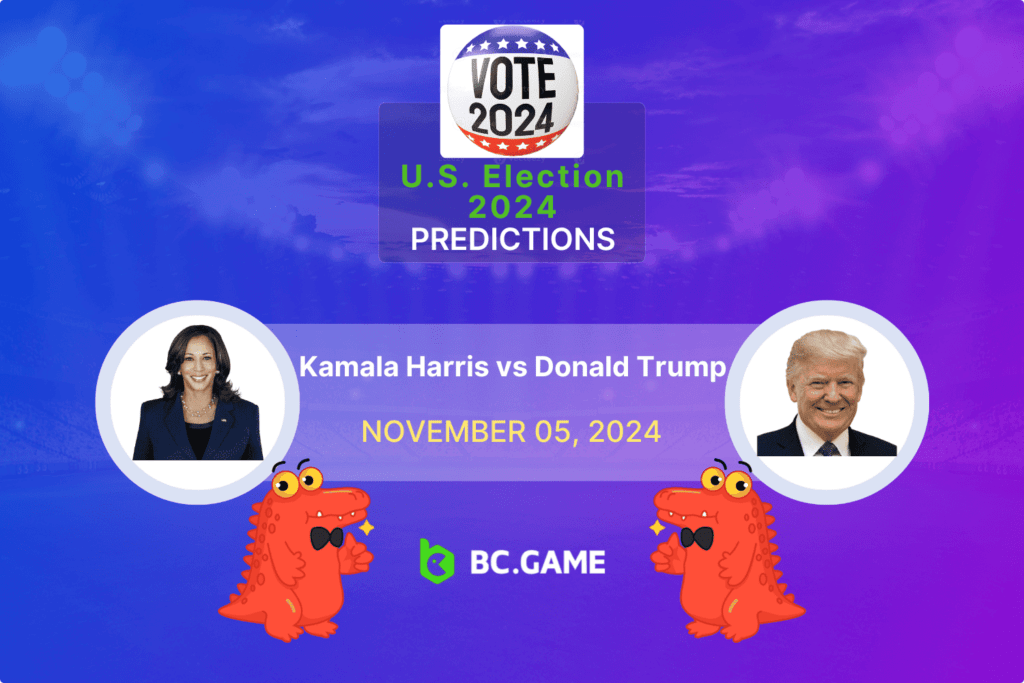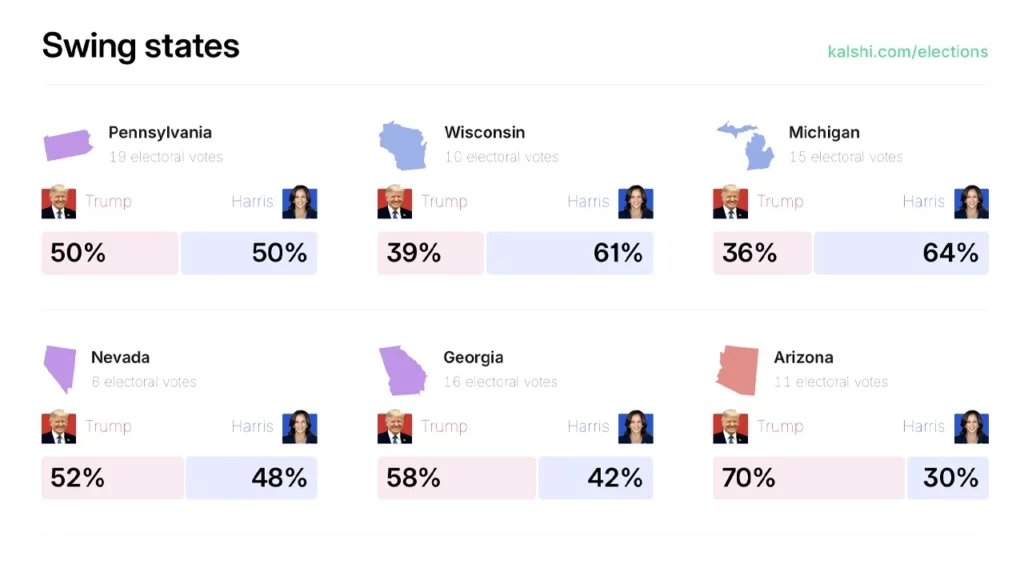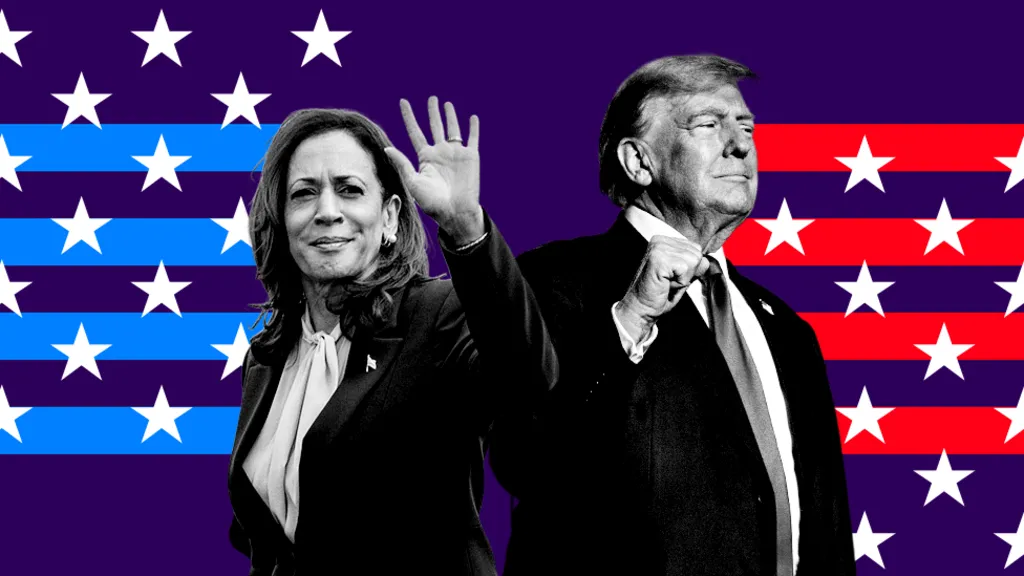
American citizens will go to vote on November 5, 2024 to choose the next president of their country. Originally scheduled as a rerun of the 2020 contest, the race took an unexpected turn in July when President Joe Biden dropped his campaign effort behind Vice President Kamala Harris. The main questions now are: will Donald Trump be able to get a second term or will the United States have its first female president? This election forecast will examine the main elements influencing the Trump vs Harris prediction, providing a whole picture of what can tip the scales in favor of either candidate, with public opinion changing and polls tightening in recent weeks.
Candidate Backgrounds: Kamala Harris and Donald Trump
- Having served as Vice President since 2021 and earlier as U.S. Senator, Kamala Harris enters the campaign as the Democratic nominee with a solid political experience. Emphasizing healthcare, environmental policy, and social fairness, her approach is based on supporting progressive changes. Using her past legislative expertise and reputation for supporting underprivileged areas, Harris’s leadership approach is characterized by a collaborative one. Her admirers consider her as the next phase of Biden’s plan, able to strengthen social justice projects.
- Former President and Republican nominee Donald Trump offers a somewhat different perspective. Emphasizing national security, economic reform, and a reversal on regulatory policies, his following is gathered around his “America First” policy Trump appeals to those who give economic recovery and a strong national security top priority as he is known for his direct, aggressive approach. Drawing analogies to his previous term and using his outsider status to the present government, his experience as president lends a special edge.
As polls tighten, the question remains: Does Trump have a chance to reclaim the White House?
Republicans vs Democrats: Key Differences and Election Dynamics
The Republican and Democratic parties reflect different and sometimes conflicting ideas, policies, and future visions of the United States in the 2024 contest. This basic split influences not just the platforms and methods of every candidate but also the problems that appeal to their particular followers.
Policy and Ideology
- Republicans emphasize individual responsibility, free-market principles, and a more limited government role. Their platform typically prioritizes tax cuts, deregulation, and a strong national defense. Republicans appeal to voters who prioritize traditional values, smaller government, and conservative social policies. Under Donald Trump, the GOP has embraced an “America First” stance, focusing on national sovereignty, economic protectionism, and reducing immigration.
- Conversely, Democrats favor projects aiming at social fairness, healthcare reform, climate action, and a more active government involvement in tackling society problems. Usually, the Democratic platform supports civil rights protections, more social services, and progressive taxes. Targeting a varied base of urban, young, and minority voters, Kamala Harris’s campaign veers into these topics stressing diversity, climate resiliency, and healthcare access.
Social and Cultural Issues
- Conservatives on social matters, Republicans embrace conventional wisdom on marriage, family, and religious values. Usually appealing to those who want to preserve more conventional values and are cautious of fast cultural change is the GOP. Issues including gun rights, anti-abortion resistance, and limited government interference in social concerns fit their base—that of suburban and rural voters.
- Democrats promote rights connected to LGBTQ+ concerns, reproductive freedom, criminal justice reform, and progressive policies on social problems. Aiming to solve structural disparities and advance social justice, Harris’s campaign follows this strategy and draws urban, younger, and varied voters that relate with these issues.
Economic Policy
- Republican economic policies, especially for companies, concentrate on lowering taxes to boost development and support a laissez-faire approach to the economy. Trump’s focus on tax cuts and deregulation is meant to increase economic independence and company investment.
- Democratic economic policies are inclined towards a more robust social safety net, increased minimum wages, and progressive taxation to address income inequality. Harris advocates for a more equitable economy, including expanding access to healthcare and affordable housing, targeting middle-class and lower-income Americans.
Approach to Foreign Policy
- Republicans traditionally emphasize a strong military and an assertive foreign policy. Under Trump, the party has favored reducing international commitments, renegotiating trade deals, and focusing on a self-reliant, “America First” approach.
- Democrats typically favor multilateralism, maintaining alliances, and addressing global challenges like climate change. Harris supports continued cooperation with allies and strengthening international ties, reflecting a more globally integrated policy stance.
Election Dynamics in 2024
The divide between Republicans and Democrats is particularly pronounced this election, with each party focusing on its core issues and seeking to mobilize its base. Swing states remain a battleground, with voters split on these ideological differences. The outcome will hinge on which vision voters believe will best secure America’s future in a time of economic and social complexity.
Current Polling Data: National Trends and Swing States
In national polling averages, Harris has maintained a slight lead over Trump since entering the race in late July. Initially, Harris’s numbers surged, with her lead widening to nearly four percentage points by late August. However, by October, her lead began to shrink, reflecting a nation still divided along ideological lines. Polls offer insights into overall popularity, but in the U.S. electoral system, the real story lies in the swing states.
The Electoral College system requires candidates to secure at least 270 electoral votes to win. Although the U.S. has 50 states, the battleground or swing states are the ones truly in play. These states, which include Arizona, Georgia, Nevada, and Pennsylvania, have seen back-and-forth polling results in recent months, making any 2024 presidential election prediction complex and dynamic.
Key Swing States and Polling Margins
- Arizona: Trump currently holds a small lead, but polling averages remain within a tight margin;
- Georgia and North Carolina: Similar trends show Trump with a minor advantage, yet Harris remains close;
- Pennsylvania: A critical state with substantial electoral votes, where Trump holds a narrow lead. This state turned red under Trump in 2016 but was reclaimed by Biden in 2020. Harris’s ability to regain Pennsylvania is crucial to her path to victory;
- Michigan and Wisconsin: Harris maintains slight leads in these traditionally Democratic strongholds, though the margins have narrowed;

source: news.bitcoin
Poll analysts caution that polling error and variance have influenced recent elections, as seen in both 2016 and 2020. This brings an added layer of uncertainty to the presidential predictions for 2024.
Key Factors Influencing Voter Preferences
- Economic Conditions: For many voters in 2024, economic stability takes the stage. Issues most affecting swing-state voters are inflation, job stability, and cost of living. While Harris wants to build on Biden’s recovery plans, targeting a sustainable and fair economy, Trump’s campaign has concentrated on returning to a pre-pandemic economy.
- Social Issues and Security: Voter sentiment is also swayed by social policies, including healthcare, immigration, and crime rates. Harris’s platform emphasizes expanded healthcare access and immigration reform, while Trump appeals to voters concerned with border security and a stronger stance on law enforcement. For voters in swing states like Arizona and Georgia, these issues may be decisive.
- Foreign Policy and National Security: International relations have increasingly become a focal point. Trump’s “America First” policy contrasts sharply with Harris’s approach, which involves maintaining alliances and addressing global issues collaboratively. For voters prioritizing national security, particularly in suburban areas, foreign policy could be a determining factor.
- Impact of Previous Election Trends: Though they offer information, prior election trends also show how erratic the American voters are. Polling differences in both 2016 and 2020 elections were mostly ascribed to concealed Trump support and an underestimating of non-college educated voters. Since then, polling changes have been done; nonetheless, it remains a matter of debate whether these changes will fairly depict Trump’s support in 2024.
Campaign Strategies: Contrasting Approaches
In terms of campaign strategy, the Trump vs Harris forecast underscores each candidate’s unique approach. Harris’s strategy is to appeal to a broader coalition, emphasizing inclusive policies that resonate with both urban voters and diverse communities. Her team is focused on high-turnout urban areas and college-educated voters, particularly women, who have been key to recent Democratic victories.
Trump’s approach, in contrast, aims at energizing his existing base while winning back disillusioned suburban voters and non-college-educated individuals, especially in pivotal states. His rallies have targeted states where Republicans have gained ground recently, such as Georgia and Arizona. His campaign’s digital and media presence continues to target a voter base that has historically been less responsive to traditional polling methods, adding an element of unpredictability to any election forecast 2024.
Betting Market Trends: An Alternative Perspective
Betting markets, while distinct from polling, offer insights into public sentiment around election outcomes. Recent changes in betting odds have favored Trump, with many platforms showing a strong increase in his chances.This trend suggests a potential undercurrent of support that could be missed in polls, particularly among swing-state voters.
While betting markets are not infallible and have occasionally been wrong, they reflect broader public interest and the possibility of a Trump victory in the Electoral College, even if Harris is projected to win the popular vote. The divergence between polling data and betting odds highlights the high stakes and deep ideological divides defining this election.

source: bbc.com
Final Prediction
The predictions for 2024 election paint a picture of an exceedingly close race. Harris maintains a slight edge in national polls and in several swing states, but Trump’s support appears stronger in the Electoral College. National polling aggregators like FiveThirtyEight and RealClearPolling show Harris leading by narrow margins, though swing-state figures remain volatile and within margins of error.
Considering all factors, the election prediction 2024 is ultimately too close to call. Harris holds an advantage in the popular vote and in traditional Democratic strongholds, but Trump’s narrow lead in key swing states combined with his strong betting market performance signals that he could once again outperform polling expectations. Much like the previous elections, this race is shaped by deep-seated divisions, with no clear frontrunner in the Trump vs Harris prediction.
Our Prediction: Donald Trump Wins the 2024 Presidential Election
| Prediction Type | Prediction | Odds |
| Winner | Donald Trump wins | 1.52 |
If you’re looking to make a wager on this close presidential race, a bet on the Kamala Harris vs Donald Trump outcome is available on bc.game, where you can follow the odds and place your prediction.
$ 0.00
$ 0.00
Conclusion
Both contenders are fighting for every vote that is accessible as Election Day approaches, particularly in battleground states with very narrow margins. If Harris confirms her leads in important states, she might win historically and become the first female president of the United States. On the other hand, Trump has a good possibility of winning the Electoral College if his swing-state performance keeps being strong.
In the end, even if public opinion polls and betting markets provide insightful analysis, the American electoral scene is still convoluted and erratic. With both candidates having routes to success, election prediction 2024 points toward a close finish and leaves America on the brink of a crucial choice that will determine the course of the country.











